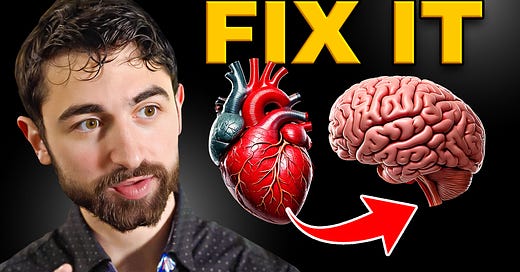How Heart Diseases Causes Brain Damage: And How THESE Specific Foods Can Help
Unhealthy heart, = Unhealthy brain. This is not just an association. Your organs talk to each other. Let's talk about new data and how to heal their relationship to support your overall health
A Quick THANK YOU! First off, today is my graduation from Harvard Medical School. So, inevitably, I’m spending the morning with a Yerba Mate and a new paper to celebrate becoming Nick Norwitz MD PhD. It’s certainly a time to reflect and be grateful. And I’m incredibly grateful for all of you and your shared enthusiasm for metabolic health. I’m beyond thrilled to be able to ‘rebound’ what I learn off of all of you. So, a huge THANKS! This is just the beginning of our journey together! Now, today’s metabolic lesson…
If you have an unhealthy heart, you probably have an unhealthy brain. But this is not just an association. Your organs talk to each other. And if you have heart disease or “atherosclerosis,” your heart transforms from a loving spouse into an abusive partner.
New research shows how this works, and we’re going to break it all down. I’m going to tell you how to potentially “intercept” the abusive messages to protect your brain (and your heart) and heal their relationship to support your overall health and wellbeing.
The new research in question was just published in Cell Metabolism and specifically reveals how immune cells in the heart called foam cells release little packages called exosomes containing messages called microRNA. These travel to the brain, where they cause oxidative stress, impair glucose metabolism, and otherwise cause metabolic dysfunction.
Important Definitions: Foam Cells, Exosomes, microRNA
Let’s define these three buzzwords quickly:
Foam cells are a type of immune cell called a macrophage that exist in plaques in coronary arteries and are core to the development of atherosclerotic cardiovascular disease. If macrophages are Bruce Banner, foam cells are Hulks—smashing and damaging all in their path.
Exosomes are small, membrane-bound spherical packages that float around in the blood and carry biological cargo like proteins, lipids, and nucleic acids to other cells.
microRNA: In this case, the microRNA are the messages in the exosome packages. microRNA are small RNA molecules. RNA is the readout from your DNA—your genome. While some RNA, called mRNA, is used to make proteins, other RNA has regulatory jobs. microRNA are genetic regulators that change how DNA is read in cells throughout the body.
So, putting it together: in heart disease (atherosclerosis), foam cells in plaques in the heart send out exosome packages filled with angry messages. These abusive messages go to the brain and change metabolism—for the worse.
Let’s Look at the Data
First, the researchers looked for an association between atherosclerosis—measured by CIMT (carotid intima-media thickness)—and a form of brain damage called white matter hyperintensities. It’s not important you know exactly what these are, but it is important to note that there was a strong association between atherosclerosis and brain damage in humans. This relationship persisted even after adjusting for confounding factors like blood flow, age, smoking, alcohol intake, and diabetes.
But to determine causality—i.e., that the atherosclerosis was actually causing brain damage—researchers turned to animal models.
Exosomes Cause Cognitive Decline in Animals
They developed a mouse model of atherosclerosis and took exosomes from both diseased and control mice. Then, they transferred these exosomes into healthy mice.
Remarkably, only the exosomes from atherosclerotic mice caused cognitive dysfunction in the recipient mice. This proves a causal connection between exosomes from animals with heart disease and brain dysfunction.
Exosomes Target Microglia in the Brain
Question: Which brain cells are affected?
Answer: microglia—the immune cells of the brain.
These are the janitors, repairmen, and firefighters of your central nervous system. But when the exosomes from heart disease mice arrived, they disrupted glucose metabolism in microglia and pushed them into a pro-inflammatory state.
To confirm human relevance, the researchers repeated the process using exosomes from human patients with atherosclerosis. These were applied to cultured human microglia. Again, same results: increased inflammation, oxidative stress, and mitochondrial dysfunction.
Specifically, these exosomes inhibited complexes I and II of the electron transport chain—a central part of cellular energy production. This is like jamming both the front and back doors of metabolism inside cells.
microRNA: Message Inside the Exosome
So, what was in these exosomes?
Using advanced techniques, they traced the origin of the exosomes to foam cells and identified their core message: a specific microRNA called miR-101-3p, elevated in both the blood and exosomes of people with atherosclerosis.
And what does miR-101-3p do?
One of its main targets is the Nrf2 pathway—a protective signaling cascade that increases antioxidant enzymes and improves glucose metabolism.
Summary of Mechanism
Atherosclerosis → Foam Cells → Exosomes carrying miR-101-3p → Suppression of Nrf2 → Metabolic dysfunction in Brain → Cognitive decline
The Good News
There’s hope! The researchers showed that activating Nrf2 in the brain reversed the negative effects caused by miR-101-3p.
In simple terms: turning “ON” the Nrf2 defense system is like intercepting the abusive messages from the heart and shielding the brain.
So, how can we activate Nrf2?
The study doesn’t go into nutrition, but we will! Certain foods and nutrients can activate Nrf2 and help build resilience in both the heart and the brain.
The rest of this letter will review:
Nutritional Support for Nrf2
Specific wegetables, Tea, Coffee and Chocolate
My new favorite Nrf2-boosting drink
The world record for a 100-mile race
Healing the Heart-Brain relationship
Keep reading with a 7-day free trial
Subscribe to Nicholas’s Substack to keep reading this post and get 7 days of free access to the full post archives.







